Intel Pentium 4 6xx and 3.73EE: Favoring Features Over Performance
by Anand Lal Shimpi & Derek Wilson on February 21, 2005 6:15 AM EST- Posted in
- CPUs
Workstation Applications
Visual Studio 6
Carried over from our previous CPU reviews, we continue to use Visual Studio 6 for a quick compile test. We are still using the Quake 3 source code as our test and measure compile time in seconds. The results are pretty much in line with what we've seen in the past.
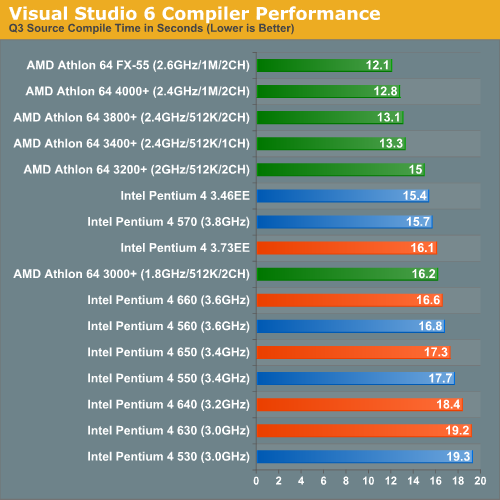
SPECviewperf 8
For our next set of professional application benchmarks we turn to SPECviewperf 8. SPECviewperf is a collection of application traces taken from some of the most popular professional applications, and compiled together in a single set of benchmarks used to estimate performance in the various applications the benchmark is used to model. With version 8, SPEC has significantly improved the quality of the benchmark, making it even more of a real world indicator of performance.
We have included SPEC's official description of each one of the 8 tests in the suite.
3dsmax Viewset (3dsmax-03)
"The 3dsmax-03 viewset was created from traces of the graphics workload generated by 3ds max 3.1. To insure a common comparison point, the OpenGL plug-in driver from Discreet was used during tracing.
The models for this viewset came from the SPECapc 3ds max 3.1 benchmark. Each model was measured with two different lighting models to reflect a range of potential 3ds max users. The high-complexity model uses five to seven positional lights as defined by the SPECapc benchmark and reflects how a high-end user would work with 3ds max. The medium-complexity lighting models uses two positional lights, a more common lighting environment.
The viewset is based on a trace of the running application and includes all the state changes found during normal 3ds max operation. Immediate-mode OpenGL calls are used to transfer data to the graphics subsystem."
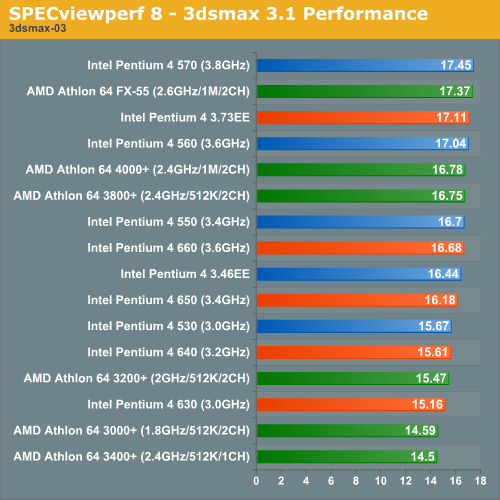
CATIA Viewset (catia-01)
"The catia-01 viewset was created from traces of the graphics workload generated by the CATIATM V5R12 application from Dassault Systems.
Three models are measured using various modes in CATIA. Phil Harris of LionHeart Solutions, developer of CATBench2003, supplied SPEC/GPC with the models used to measure the CATIA application. The models are courtesy of CATBench2003 and CATIA Community.The car model contains more than two million points. SPECviewperf replicates the geometry represented by the smaller engine block and submarine models to increase complexity and decrease frame rates. After replication, these models contain 1.2 million vertices (engine block) and 1.8 million vertices (submarine).
State changes as made by the application are included throughout the rendering of the model, including matrix, material, light and line-stipple changes. All state changes are derived from a trace of the running application. The state changes put considerably more stress on graphics subsystems than the simple geometry dumps found in older SPECviewperf viewsets.
Mirroring the application, draw arrays are used for some tests and immediate mode used for others."
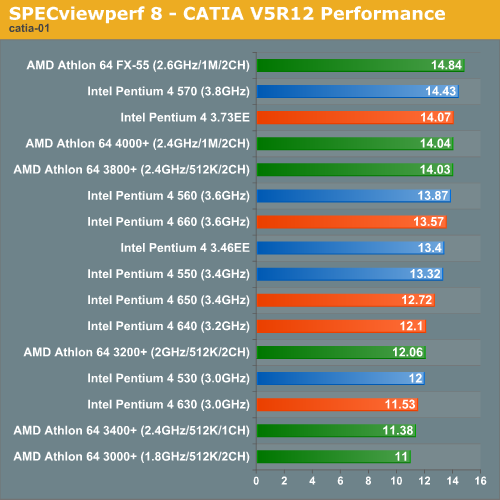
Lightscape Viewset (light-07)
"The light-07 viewset was created from traces of the graphics workload generated by the Lightscape Visualization System from Discreet Logic. Lightscape combines proprietary radiosity algorithms with a physically based lighting interface.
The most significant feature of Lightscape is its ability to accurately simulate global illumination effects by precalculating the diffuse energy distribution in an environment and storing the lighting distribution as part of the 3D model. The resulting lighting "mesh" can then be rapidly displayed."
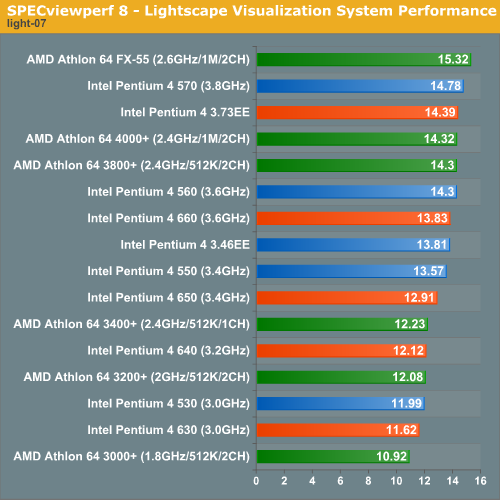
Maya Viewset (maya-01)
"The maya-01 viewset was created from traces of the graphics workload generated by the Maya V5 application from Alias.
The models used in the tests were contributed by artists at NVIDIA. Various modes in the Maya application are measured.
State changes as made by the application are included throughout the rendering of the model, including matrix, material, light and line-stipple changes. All state changes are derived from a trace of the running application. The state changes put considerably more stress on graphics subsystems than the simple geometry dumps found in older viewsets.
As in the Maya V5 application, array element is used to transfer data through the OpenGL API."

Pro/ENGINEER (proe-03)
"The proe-03 viewset was created from traces of the graphics workload generated by the Pro/ENGINEER 2001TM application from PTC.
Two models and three rendering modes are measured during the test. PTC contributed the models to SPEC for use in measurement of the Pro/ENGINEER application. The first of the models, the PTC World Car, represents a large-model workload composed of 3.9 to 5.9 million vertices. This model is measured in shaded, hidden-line removal, and wireframe modes. The wireframe workloads are measured both in normal and antialiased mode. The second model is a copier. It is a medium-sized model made up of 485,000 to 1.6 million vertices. Shaded and hidden-line-removal modes were measured for this model.
This viewset includes state changes as made by the application throughout the rendering of the model, including matrix, material, light and line-stipple changes. The PTC World Car shaded frames include more than 100MB of state and vertex information per frame. All state changes are derived from a trace of the running application. The state changes put considerably more stress on graphics subsystems than the simple geometry dumps found in older viewsets.
Mirroring the application, draw arrays are used for the shaded tests and immediate mode is used for the wireframe. The gradient background used by the Pro/E application is also included to better model the application workload."
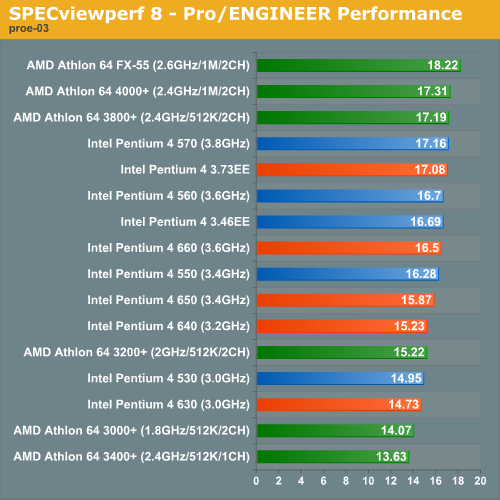
SolidWorks Viewset (sw-01)
"The sw-01 viewset was created from traces of the graphics workload generated by the Solidworks 2004 application from Dassault Systemes.
The model and workloads used were contributed by Solidworks as part of the SPECapc for SolidWorks 2004 benchmark.
State changes as made by the application are included throughout the rendering of the model, including matrix, material, light and line-stipple changes. All state changes are derived from a trace of the running application. The state changes put considerably more stress on graphics subsystems than the simple geometry dumps found in older viewsets.
Mirroring the application, draw arrays are used for some tests and immediate mode used for others."
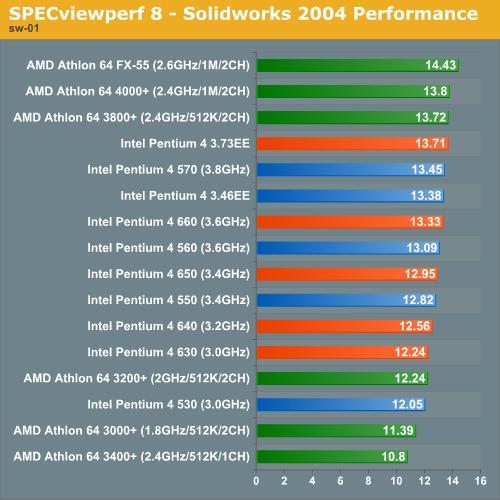
Unigraphics (ugs-04)
"The ugs-04 viewset was created from traces of the graphics workload generated by Unigraphics V17.
The engine model used was taken from the SPECapc for Unigraphics V17 application benchmark. Three rendering modes are measured -- shaded, shaded with transparency, and wireframe. The wireframe workloads are measured both in normal and anti-alised mode. All tests are repeated twice, rotating once in the center of the screen and then moving about the frame to measure clipping performance.
The viewset is based on a trace of the running application and includes all the state changes found during normal Unigraphics operation. As with the application, OpenGL display lists are used to transfer data to the graphics subsystem. Thousands of display lists of varying sizes go into generating each frame of the model.
To increase model size and complexity, SPECviewperf 8.0 replicates the model two times more than the previous ugs-03 test."
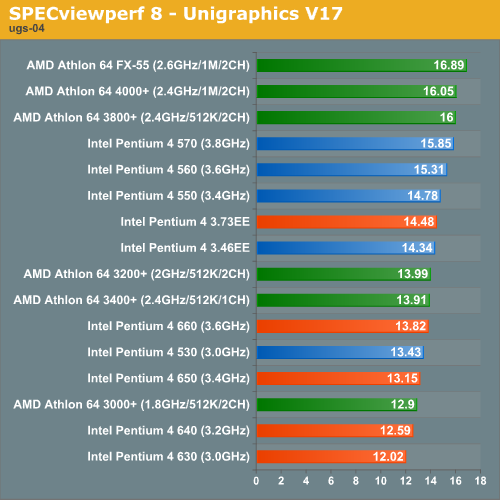










71 Comments
View All Comments
L3p3rM355i4h - Monday, February 21, 2005 - link
#30 90mm SOI= lower wattage.Brian23 - Monday, February 21, 2005 - link
Look at the power consumption graph for the A64. Why is the 3500 winchester doing so much better than the 3000 and 3200 winchesters?L3p3rM355i4h - Monday, February 21, 2005 - link
#28 saw almost the same thing at PCPER too.Aenslead - Monday, February 21, 2005 - link
I could ALMOST swear I saw the VERY same bencmarks last night @ xbit labs... fancy that.bldckstark - Monday, February 21, 2005 - link
227 WATTS!!... My daughter has a crayon maker. It uses a 60W light bulb in a plastic box to melt 3 crayons and pours them into a mold. It melts the wax in about 5 minutes. If I buy a P4 I can melt 11.35 crayons at once. It uses 3.78 times as much energy as is necessary to light my computer room. This is not efficient use of resources.L3p3rM355i4h - Monday, February 21, 2005 - link
sorry to go off topic, but are the forums down or does this terminal suck?LoneWolf15 - Monday, February 21, 2005 - link
From a price/performance standpoint, I can't see many good reasons to buy a P4 six series, and in many cases, a five series either (exceptions being high-end 3D rendering apps and heavy video encoding). Not just because of what price of processor (which doesn't seem to net a huge speed increase) but the increased power draw means a heavier power supply, plus more expensive cooling. Compared to the lower power draw of the Athlon 64 CPU's, as well as a lower price at least at the entry-to-mid level CPU's, I think Intel really needs to go back to basics and create a new CPU architecture.mlittl3 - Monday, February 21, 2005 - link
Okay, I have an addition to my last comment made about the Extreme Edition being a scam. I did some calculations that were left out my anandtech to see if the 3.73EE is truely better than the 3.46EE.Everyone knows the differences between the two processors. The 3.73EE has an 8% increase in CPU speed, less total cache overall but 4x the lower latency L2 cache when compared to L3 cache (the XD-bit and EM64T are also added but that will not effect performance at all with 32-bit OS).
With these added features, the 3.73EE should be better than the 3.46EE especially since the Prescott core is supposed to scale well with clock speed versus the Gallatin/Northwood and the 1066 MHz FSB is supposed to give better performance at higher clock speeds. Well, let's look at the numbers.
Using Anandtech's results, I calculated the % difference between the two processors. They varied between -10 (worse) and 30 % (better). I then added up all the scores (I took the inverse of the less is better scores) and divided them by the introduction price ($999) and the MHz of each processor. Here are the results.
Performance per $:
3.46EE - 20.69
3.73EE - 20.61
Performance per MHz:
3.46EE - 5.96
3.73EE - 5.52
You can do the calculations yourself by using all the benchmark numbers from the two extreme edition CPUs in the review. As you can see, the 3.73EE is worse on a per dollar and per MHz basis compared to the 3.46EE (even though the margin is small, it is still worse for the higher clocked CPU). The Prescott core is a failure IMHO. The 3.73EE is a total scam and the extreme edition processors in general are poor performers. Remember these were released just to offset the marketing of AMD FX processors when Intel got wind of them 1.5 years ago. I don't think Intel was ever going to release them and they keep getting worse and worse.
A scam alert should be issued. Buyer beware!
L3p3rM355i4h - Monday, February 21, 2005 - link
Ho Hum, intel is still stagnating. 227 watts load? Jeezus, thats incredible.mlittl3 - Monday, February 21, 2005 - link
Just a quick, possible correction.I don't know if you meant to or not, but the comparison of the Prescott vs. Prescott 2M table is missing Windows Media Creator HD and Visual Studio results.